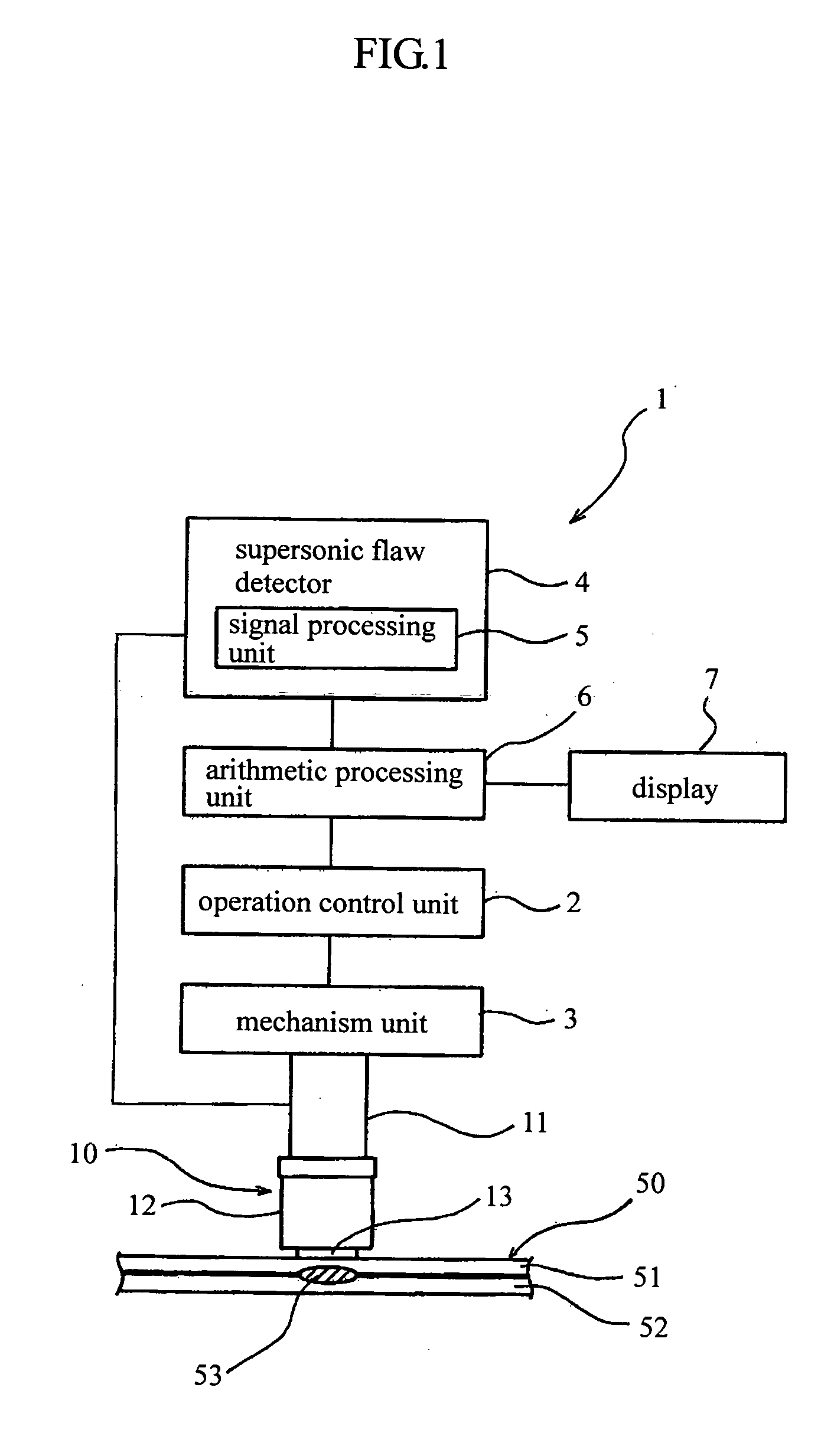Supersonic sensor head for supersonic non-destructive test apparatus
a sensor head and supersonic technology, applied in the direction of instruments, fluid loss/gain rate measurement, fluid tightness measurement, etc., can solve the problems of difficult operation, affecting test accuracy, and difficult to maintain the durability of the free end, so as to facilitate the deformation of the contact medium
- Summary
- Abstract
- Description
- Claims
- Application Information
AI Technical Summary
Benefits of technology
Problems solved by technology
Method used
Image
Examples
first embodiment
(First Embodiment)
[0041] A first embodiment of a supersonic sensor head for a supersonic non-detective test apparatus according to the present invention will be explained by referring to FIGS. 1 and 2. FIG. 1 is a schematic diagram for explaining a supersonic non-destructive test apparatus 1, and FIG. 2 is a cross section for showing the supersonic sensor head in FIG. 1.
[0042] In the supersonic non-destructive test apparatus 1, a sensor head 10 with a supersonic vibrator 11 causes a mechanism unit 3 to move based on a control signal transmitted from an operation control unit 2. Then, the supersonic sensor head 10 is pressed against a surface of a test object 50. In this state, a supersonic wave is transmitted from a supersonic flaw detector 4 to a supersonic vibrator 11 of the supersonic sensor head 10 through a signal treatment unit 5 in the supersonic flaw detector 4 and an arithmetic processing unit 6. The supersonic wave is output from the vibrator 11 to the test object 50 and ...
second embodiment
(Second Embodiment)
[0055]FIG. 3 is a schematic cross section for explaining a supersonic sensor head as a second embodiment. Structural parts in FIG. 3 corresponding to those in FIG. 2 are shown with the same reference numerals in both the figures, and the explanation on the corresponding parts will be omitted.
[0056] A supersonic sensor head 20 in the second embodiment is in the form of a column having a flat free end 11a, as in the first embodiment. A holder 22 is provided coaxially with a supersonic vibrator 11 with being connected to the free end 11a of the supersonic vibrator 11. The holder 22 is detachably connected to the outer periphery of the supersonic vibrator 11 at a lower position thereof. The holder 22 contains a contact medium 25 therein, similar to the first embodiment. The contact medium 25 is also made of a gel material such as a silicone rubber. The holder 22 is made of a material which makes it difficult for a supersonic wave to be transmitted therethrough. The h...
third embodiment
(Third Embodiment)
[0062]FIGS. 4A and 4B are schematic diagrams for explaining the supersonic sensor head as a third embodiment of the present invention. FIG. 4A is a cross section of the supersonic sensor head, and FIG. 4B is a diagram of the supersonic sensor head obtained by viewing FIG. 4A in the direction of an arrow A in FIG. 4A. Structural parts in FIG. 4 corresponding to those in FIGS. 2 and 3 are shown with the same reference numerals therein and the explanation on the corresponding parts will be omitted.
[0063] A supersonic sensor head 30 in the third embodiment is in the form of a column having a flat free end 11a as in the first embodiment. A holder 32 with a converging mechanism 35 is provided coaxially with the supersonic vibrator 11 with respect to an axis a, by being connected to the free end 11a of the supersonic vibrator 11. The holder 32 contains a contact medium 40 therein, similar to the first embodiment. The contact medium 40 is also made from a gel material suc...
PUM
 Login to View More
Login to View More Abstract
Description
Claims
Application Information
 Login to View More
Login to View More - R&D
- Intellectual Property
- Life Sciences
- Materials
- Tech Scout
- Unparalleled Data Quality
- Higher Quality Content
- 60% Fewer Hallucinations
Browse by: Latest US Patents, China's latest patents, Technical Efficacy Thesaurus, Application Domain, Technology Topic, Popular Technical Reports.
© 2025 PatSnap. All rights reserved.Legal|Privacy policy|Modern Slavery Act Transparency Statement|Sitemap|About US| Contact US: help@patsnap.com



